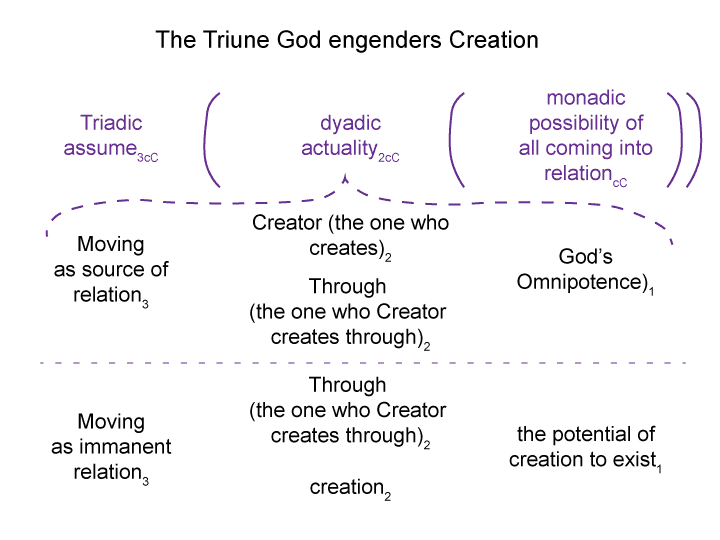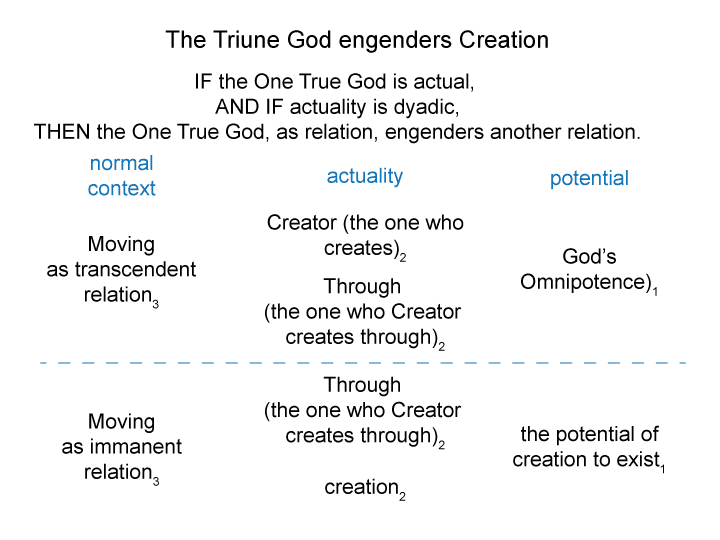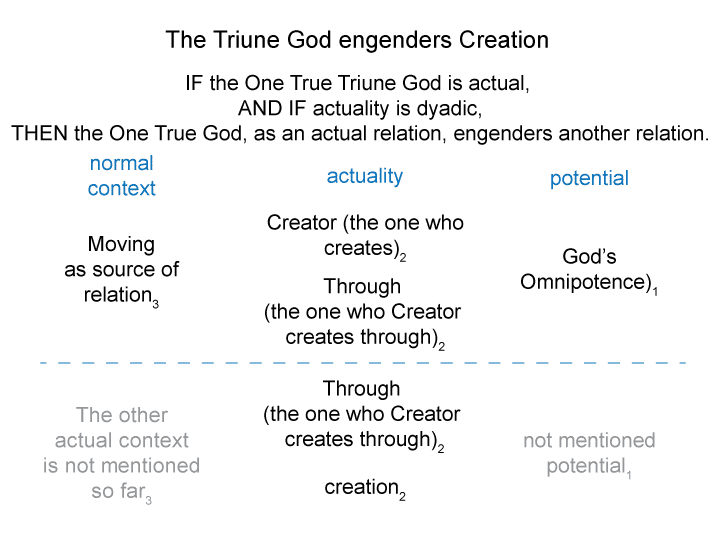Man and Sin by Piet Schoonenberg (1964) 2.1BV
[Assume brings everything into relation, including every one of us, past, present and future. Assume brings all creation into relation. “All creation” includes the entire universe.
Creation, however, is not mentioned in the nested relation that portrays the One True Triune God.
Therefore, creation must belong to the other element in the dyad that we assume in order to bring all into relation.
The next blog portrays a way to picture how creation2 fits the dyadic actuality that “assume3” contextualizes.]
Man and Sin by Piet Schoonenberg (1964) 2.1BU
Summary of text [comment] page 67
[OK, here is another logical conclusion:
If the One True Triadic God is actual, then that actuality belongs to another nested form.
What triadic relation is able to put this actuality into context.
Islam provides a clue with the notion that Quran means “recite”.
Islam means “submit”.
I prefer another word: “Assume”.
Assume3( the actuality of the One True Triune God plus some other element in a dyad2(possibility of all being brought into relation1))]
Man and Sin by Piet Schoonenberg (1964) 2.1BR
Summary of text [comment] page 67
[Let me examine each word in the term “The One True Triune God”.
The term, “One”, refers to possibility. The realm of possibility is monadic. It is all inclusive. It allows contradictions. Omnipotence means “all potential”. There is only One God in the category of firstness.
The term, “True”, refers to actuality. A True God must exhibit the dyadic nature of the category of secondness. In this, a True God both constitutes and realizes the laws of noncontradiction. A True God should harbor no contradictions.
Finally, the term, “Triune”, refers to the triadic relation itself.
The term, “God”, refers to the object that brings all into relation. If we assume this object, all are brought into relation.
Relations are exclusive. There is only one relation, even though there may be many manifestations of this one relation.]
Man and Sin by Piet Schoonenberg (1964) 2.1BQ
[Here is another way to say it:
Actuality is always dyadic. God is actual. Both actualities in the dyad must be divine. Both are perceived as Persons. This accounts for Two Persons.
Dyadic actuality exists in relation to a triadic normal context and a monadic possibility.
God is both actual and relational.
The actuality of “God as a triadic relation” engenders another Person in addition to the dyad.
The triadic relation itself constitutes the third Person.
The Third Relational Person brings the Two Actual Persons into relation with “the Oneness of God”.
The “Oneness of God” cannot be expressed as a Person because it is Pure Potential, that this, Omnipotence.]
Man and Sin by Piet Schoonenberg (1964) 2.1BP2
Summary of text [comment] page 67
[Thus, God is Father2, Son2 and Holy Spirit3.
Thus, God is Creator2, Through2, and Moving3.
“This Relation of Moving” accounts for “our created world”.
Thus, God is “the One Who Recognizes”2, “the One Who Is Recognized”2, and “Recognize!”2.
“This Relation Of Recognition” constitutes “the actuality in which we live as humans”.
Since “God Is Omnipotent1” and we humans arise out of pure potential, we are constituted by that relation, even though we may misrecognize our own actuality.]
Man and Sin by Piet Schoonenberg (1964) 2.1BP1
[Indeed, only one Possibility supports the diverse appearances of God’s dyadic Actuality.
Each actuality is contiguous with the other. Both (the dyad itself) stand in relation to the realm of possibility. That Relation is also a Person. That relation is the Third Person.
God Is Three means that “the recognition itself exists as a triadic relation”. Recognize (maybe there should be an exclamation point) is the third Person of the Trinity.
“The One Who Recognizes2” and “The One Who Is Recognized2” are “in Relation3 with “the Possibility of Recognition1”.]




